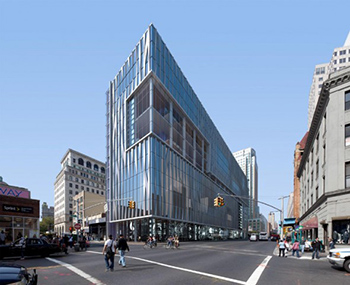NYU Scraps Rebuild for Sustainable Renovations
 BROOKLYN, N.Y. — NYU has overhauled plans to turn a dilapidated building in Brooklyn into a futuristic steel structure with a glass curtain. While the university plans to move forward with a five-year construction plan starting in 2015, it has opted for eco-friendly renovations instead of rebuilding the 500,000-square-foot structure.
BROOKLYN, N.Y. — NYU has overhauled plans to turn a dilapidated building in Brooklyn into a futuristic steel structure with a glass curtain. While the university plans to move forward with a five-year construction plan starting in 2015, it has opted for eco-friendly renovations instead of rebuilding the 500,000-square-foot structure.
The university agreed in 2012 to take over the building at 370 Jay St. to house the NYU Center for Urban Progress (CUSP). Originally home to the Metropolitan Transportation Authority, the 14-story structure has been vacant in recent years, and community members have been eager to revamp it, calling it one of the five ugliest buildings in downtown Brooklyn.
While original plans called for floor-to-ceiling windows, new floor plates and a first-floor atrium with a subway entrance, the project — unveiled on June 26 — will instead restore the building’s original limestone and steel façade, which will save 4,000 cubic yards of landfill waste.
When it was built in 1951, 370 Jay was viewed as a template for modern office buildings with a design that allowed natural light to reach the center of each floor plate. NYU will keep the traditional look and will install more than 1,000 energy-efficient windows with high-performance glazing and optimized sills and shades, along with other elements of a high-performance envelope that will improve energy performance by 26 percent.
Other sustainable elements will be added including a new, dedicated outdoor air HVAC system with heat recovery; a microturbine to generate electricity on-site; advanced metering and control systems; and efficient lights and faucets. It’s estimated these elements will cut annual utility usage by more than 50 percent. Performance upgrades are projected to reduce annual energy source consumption by 37 percent and CO2 emissions by 21 percent.
 What’s more, a 1-megawatt microturbine will behave as a local high-efficiency/low-waste source of electricity, similar to a cogeneration plant, and will allow new facilities to be come online within the building without adding strain to the city grid. Thermal ice storage will create extra insulation during off-peak hours, maximizing the microturbine’s efficiency and reducing peak electrical demand.
What’s more, a 1-megawatt microturbine will behave as a local high-efficiency/low-waste source of electricity, similar to a cogeneration plant, and will allow new facilities to be come online within the building without adding strain to the city grid. Thermal ice storage will create extra insulation during off-peak hours, maximizing the microturbine’s efficiency and reducing peak electrical demand.
At the top of the building, green roofing and reflective rooftop surfaces will reduce the heat island effect.
“We did a careful examination on how to adaptively reuse the building without creating a significant amount of waste,” said Andrew Repoli, project manager for NYU, in a statement. “We looked at various green-building features, but found there was no sustainable benefit to stripping off the original façade. Instead, we incorporated it into our design. Equally as important, this design aligns our approach with CUSP’s mission of helping cities operate more efficiently.”
Working with Mitchell Giurgola Architects, construction manager Skanska USA and sustainability consultant Atelier Ten, all with offices in New York, NYU still intends to house CUSP on the top three floors, and the remainder of the building will be used for classrooms and other academic purposes. The ground floor will have 14,000 square feet of retail space instead of the atrium and subway entrance.
“The new 370 Jay Street will come alive with the sounds of learning and innovation, as NYU’s CUSP becomes its latest and greatest tenant,” Brooklyn Borough President Eric Adams said in a statement. “I am pleased to support a project that embraces sustainable construction and energy efficiency, as Brooklyn looks to be a leader in these areas.”
